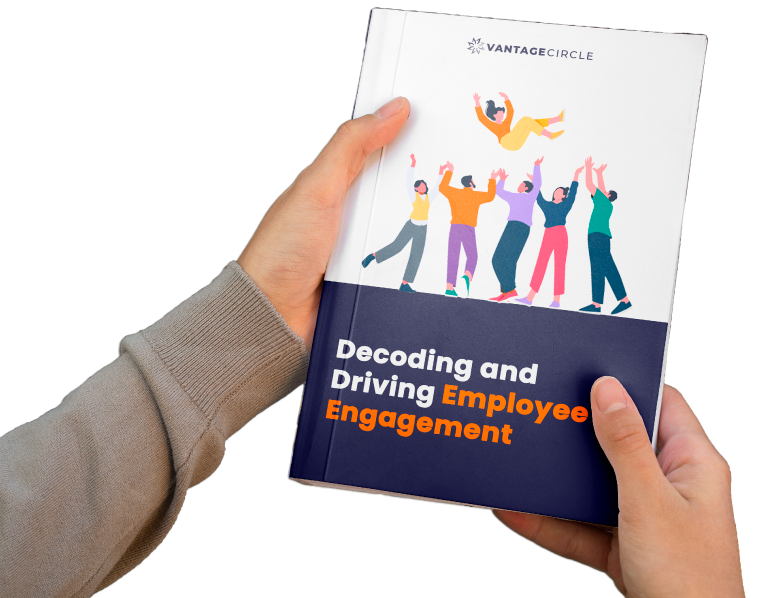How to Break Down Silos and Make Collaboration Happen

A Global Employee Recognition and Wellness Platform
Digital transformation isn't just about tools and technology, it's about people. Yet one of the biggest hurdles to transformation isn't technical at all. It's organizational silos.
A 2017 Harvard Business Review Analytics Services survey indicates that 67% of collaboration failures are due to silos.
Organizational silos form when departments or teams operate in isolation while focusing on their own goals, tools, and processes, with little communication or collaboration with other parts of the business. They can emerge due to company structure, lack of shared priorities, or outdated systems limiting information flow.
According to McKinsey, cultural barriers like siloed thinking and resistance to change are among the top reasons transformation efforts fall short. If we want real, lasting change, we must break down the walls between teams and build something better.
In today's fast-moving world, where speed, agility, and collaboration drive success, many organizations still operate in fragmented pockets. Teams are aligned vertically but disconnected laterally. Information gets stuck, collaboration weakens, and culture suffers.
In this blog, we'll explore practical ways to break these barriers and build a culture where collaboration isn't the exception, it's how we work daily.
The Impact of Silos in a Rapidly Evolving Business Landscape

So, what impact do silos have? In the current market scenario, silos can lead to slower decision-making, missed opportunities for innovation, reduced responsiveness to market changes, and decreased employee engagement. For instance, in a recent joint study between theInstitute for Corporate Productivity (i4cp) and Rob Cross, Edward A. Madden, Professor of Global Business at Babson College , found that companies that promoted collaborative working were 5 times as likely to perform highly. This underscores the importance of breaking down silos to foster a more agile and innovative organization.
Types of Organizational Silos

Before we can break down silos, you need to recognize where and how they show up. Silos aren't always obvious—and they're not limited to departments alone. Here are the most common types that can quietly divide an organization:
Departmental Silos
These are the most visible silos. When departments like HR, Sales, or IT operate in isolation, they prioritize their goals over shared outcomes. The result? Misaligned priorities, redundant work, and loss of communication.
Hierarchical Silos
When information only flows top-down or bottom-up, valuable insights from junior employees may never reach decision-makers—and strategic direction may not get to the frontline. This lack of cross-level dialogue stifles innovation and employee engagement.
Geographic Silos
Distributed or remote teams often face challenges with time zones, cultural differences, and limited face-to-face interaction. These teams can feel disconnected from the broader organizational mission without intentional connection.
Schedule Silos
Different working hours, shifts, or hybrid models can make real-time collaboration tricky. When teams rarely overlap, feedback loops slow down, and decisions take longer—impacting agility and productivity.
Functional Silos
Specialization is valuable, but teams work in narrow lanes when functions like marketing, sales, and product don't align. Without regular cross-functional collaboration, the customer journey becomes fragmented.
Project-Based Silos
Project teams sometimes operate in a bubble—focused on their deliverables without looping in others. This leads to duplicated efforts, miscommunication, or missed opportunities for alignment.
The High Cost of Isolation: Negative Impacts of Silos

We’ve all been there—working hard in our own team, only to realize later that someone else was doing something similar, or that a great idea didn’t reach the people who needed it. That’s what happens when silos form at work.
Silos are when teams or departments don’t talk to each other enough. At first, it might not seem like a big deal. But over time, it slows everything down. Decisions take longer, new ideas get stuck, and people start feeling like they’re working alone instead of together.
When teams don’t share information or work together, companies miss out on chances to grow, move fast, or solve problems creatively. It can also hurt team spirit—because it’s hard to feel connected to the bigger picture when you're kept in the dark.
If we want to build a workplace where people feel included, valued, and able to do their best work, breaking down silos is a must.
1. Productivity Losses
When teams don't communicate effectively, tasks get repeated, timelines slip, and resources go underutilized. The Project Management Institute (PMI) reported that ineffective communication contributes to 56% of project failures, highlighting it as a leading cause of unsuccessful projects —a direct consequence of siloed operations.
2. Innovation Stifled
Silos prevent the cross-pollination of ideas across functions. When marketing doesn't talk to product, or operations don't loop in customer support, it breaks the feedback loop. As a result, knowledge sharing and innovative thinking comes at a halt.
3. Employee Engagement Decline
A siloed workplace often creates an "us vs. them" culture, where employees feel disconnected from other teams and the company's broader mission. This emotional and professional isolation can lead to disengagement. Gallup data shows that only 33% of employees are engaged at work, and siloed environments are a major contributor.
4. Overall Business Performance Reduction
From slow decision-making to inconsistent customer experiences, silos directly hit the performance. Disconnected teams lead to longer product cycles, delayed responses, and misaligned goals, all hurting profitability and growth.
Building Bridges: Strategies and Techniques for Breaking Down Silos
Let's look at what works when breaking down walls and building connections across your organization.
1. Bring Teams Together with Cross-Functional Collaboration
Some of the most game-changing ideas come from unexpected partnerships. Take Spotify, for instance. They use "squads" and "tribes" small, cross-functional teams with end-to-end ownership over features. Each squad includes designers, developers, marketers, and analysts who work together like a mini-startup. This model not only boosts speed but also creates natural collaboration.
Thus, you don't need a total organisational redesign to try this. Even forming a temporary task force for a campaign, product launch, or process revamp can create collaboration space and spark creativity.
2. Keep the Bigger Picture Front and Center
People want to know their work matters.
A simple step like a "why it matters" slide in every team update or linking team KPIs to company OKRs can keep the focus on shared outcomes—not isolated wins.
3. Create Spaces for Open Communication
Communication doesn't always have to be formal. Open-door policies are significant, but open channels are even better. Communication has to flow, whether it's regular team huddles, company-wide town halls, or just a shared chat group for project updates. Tools like Slack, Teams, and even a simple Google Doc can go a long way in keeping everyone aligned and informed.

4. Make Knowledge Easy to Find (and Share)
We've all been there—digging through old emails or messaging five different people just to find a single document. A centralized knowledge platform can be a game-changer. Whether it's a shared drive, internal wiki, or project dashboard, ensure everyone can access the resources they need without jumping through hoops.
5. Celebrate Collaboration (Loudly and Often)
Here's the thing: people repeat what gets rewarded. When you recognize and celebrate cross-team efforts, you're showing everyone that collaboration isn't just appreciated—it's expected
So, Recognition isn't just a feel-good gesture—it's a powerful culture shaper. I was recently reading about Adobe and how, at Adobe, employees nominate peers for "kickbox" recognition when they see innovative, cross-team efforts. At Vantage Circle , we've seen firsthand how tying Recognition to collaborative milestones fuels motivation.
For example, a client in the IT sector recently started using Vantage Recognition to recognize interdepartmental achievements, such as when product, QA, and customer service teamed up to resolve a major customer pain point. This resulted in a huge morale boost for the company.
Leading the Way: The Role of Leadership in Fostering Collaboration

I remember a conversation I had with a manager a few years ago. She said, "We keep telling our teams to collaborate more, but the message doesn't stick somehow."
So, what's the way to tackle this? Collaboration isn't a checkbox on a to-do list. It's a behavior—and like any behavior, it's modeled from the top. If leaders don't actively break silos and foster connection, no number of tools or meetings can do it for them. Leadership is the culture driver. And in siloed organizations, it's the leaders who hold the key to unlocking collaboration.
Let's break down how they can do just that:
1. Articulating a Clear, Shared Vision
Have you ever been in a room where every team has their version of success? One's chasing revenue, another's obsessed with product features, and a third is trying to improve customer satisfaction—but no one's aligned. That's a recipe for silos.
Leaders need to bring everyone under one banner. Think about Microsoft's transformation under Satya Nadella. When he took over as CEO, he shifted the company's culture from "know-it-all" to "learn-it-all." That one mindset shift aligned thousands of employees around growth, curiosity, and shared wins.
According to a McKinsey study, companies with intense shared visions are almost twice as likely to have higher financial performance.
2. Encouraging Open and Transparent Communication
Mckinsey in one of its studies states, that while consistent communication is ranked as a priority, less than 40 percent of teams report practicing it. When leaders speak honestly, teams feel safe to do the same. They ask more questions, admit roadblocks, and reach out for help. That's when real collaboration begins.
Patagonia's leadership nails this. Their open-door policy isn't just symbolic—it's backed by weekly leadership huddles that include insights from every corner of the business, from warehouse workers to designers. It keeps silos from forming in the first place.
3. Recognizing and Rewarding Cross-Team Efforts
Here's a hard truth: if you're only rewarding individual achievements, you're silently encouraging silos. People naturally gravitate toward what gets them noticed and promoted.
As per the AIRe US Report shows that companies with well-designed recognition programs (scoring 70%+) were significantly more likely to report high program effectiveness, proving that when leaders take ownership of strategic recognition, collaboration improves as a cultural norm
That's why leaders must intentionally celebrate collaboration.
Research from Deloitte shows that organizations with recognition programs tied to values and behaviors see 31% lower voluntary turnover.
4. Listening Actively Through Feedback Tools
Let's be honest—leaders don't always see the silos their teams experience daily. That's why feedback matters. Tools like Vantage Pulse give leaders a clear, real-time look into how connected (or disconnected) teams feel.
Listening isn't just good leadership. It's a smart strategy.
Technology as an Enabler: Tools and Platforms for Collaboration

Collaboration is critical! While culture and leadership lay the foundation, technology sustains and scales collaboration across geographies, departments, and roles.
The right digital tools can dismantle barriers, enable real-time communication, and foster a culture of transparency and accountability. Let's explore the technologies that are transforming how modern workplaces collaborate.
1. Recognition Platforms that Encourage Cross-Team Appreciation
Studies show that organizations with strong recognition practices are 3.7 times times more likely to have high levels of employee engagement (Source:Forbes).
Recognition is a powerful motivator—and when it's public, peer-driven, and value-based, it becomes a cultural game-changer.
Recognition connects people across teams, levels, and geographies.
Platforms that allow real-time peer-to-peer Recognition — like Vantage circle, Bonusly or Kudos — help teams appreciate each other beyond job functions. These platforms also provide data-driven insights that help HR leaders spot collaboration patterns, reward top contributors, and fine-tune recognition programs.
For instance, Atlassian encourages cross-functional kudos through its internal tools and integrates rewards with values like "Be the change you seek." Their employees regularly give shoutouts in public channels to highlight teamwork across product, engineering, and customer support.
Digital recognitionplatforms make it easy for employees across departments to appreciate each other in real-time. This reinforces collaborative behavior and makes success feel collective—not confined to individual silos.
2. Survey Tools for Continuous Feedback and Alignment
Feedback is sacrosanct. It’s the bridge between what we’re doing and what we could be doing better. Feedback tools—especially lightweight, frequent surveys—reveal the cracks where collaboration breaks down.
Whether it's a misalignment between teams, poor communication, or feelings of exclusion, data gathered through regular surveys can guide targeted actions. It helps leadership understand where to intervene—and when to step back and let teams self-correct. Tools like Qualtrics, SurveyMonkey, Vantage Pulse can be really helpful in putting together a seamless feedback process.
3. Tools That Enable Seamless Daily Collaboration
No strategy will succeed unless day-to-day collaboration is frictionless. That's where the right operational tools make a real difference:
Collaboration Platforms (e.g., Slack, Microsoft Teams): Encourage real-time, cross-functional discussions and reduce reliance on endless email threads.
Project Management Software (e.g., Asana, Trello, ClickUp): Increase visibility into tasks and timelines across departments, fostering ownership and reducing bottlenecks.
Unified Data and CRM Systems (e.g., Salesforce, HubSpot): Align customer-facing teams with shared data, enabling cohesive messaging and faster decision-making.
Measuring the Invisible: Using Survey Tools to Spot and Reduce Silos

Silos in organizations aren't always easy to see. You won't find them on an org chart—but you do feel them in how people work. Teams don't talk to each other, information gets lost, and employees feel disconnected.
That's why HR teams need the right tools to identify where silos exist and check if collaboration efforts are working. And survey tools are one of the best ways to do that.
Finding Silos with the Right Survey Questions
Start by asking employees about their daily experiences. How often do they talk to other teams? Do they feel informed about what's happening across the company?
Here are a few helpful questions to include in your survey:
"I have opportunities to work with people outside my team."
"My department regularly shares information with others."
"There is a strong sense of teamwork across departments."
If responses to these are low, it's a clear sign of siloed thinking or poor communication between teams.
Measuring the Impact of Your Collaboration Efforts
Let's say you've started some new initiatives—like cross-team projects or team-wide town halls. How do you know they're working?
Survey tools help you compare responses before and after these changes. If collaboration scores go up, you're on the right track. If not, it's a sign you may need to try something different.
Tracking the Bigger Picture
Silos affect more than just communication—they can impact employee morale, productivity, and even customer satisfaction. Surveys can help track all of this over time.
Some things to measure:
Morale: Are people more engaged when they feel connected?
Productivity: Are tasks being completed faster with better teamwork?
Customer experience: Are issues getting resolved more smoothly?
Conclusion : Fostering a Collaborative Future
Silos don't just block communication—they block potential. And in today's workplace, where speed, innovation, and agility are everything, collaboration is a survival skill.
The future of work belongs to connected minds working toward a common purpose. Whether you're in HR, IT, sales, or operations—collaboration is the glue that holds everything together.
Collaboration sparks fresh ideas, removes duplication, accelerates projects, and makes people feel seen and valued.
Turning Intent Into Impact
Culture will not change overnight!It takes leadership, intention, and the right platforms to bring people closer.
It is thus important for HR leaders and employers, to not just solve problems but build bridges. You set the tone for how people work together by encouraging open dialogue, aligning goals, or recognizing cross-team wins.
And while no tool can fix culture on its own, a platform like Vantage Recognition can amplify your efforts by making collaboration visible, measurable, and meaningful. With features like real-time peer-to-peer recognition and integration with Microsoft Teams it helps highlight and reinforce collaborative behaviors across departments.
















